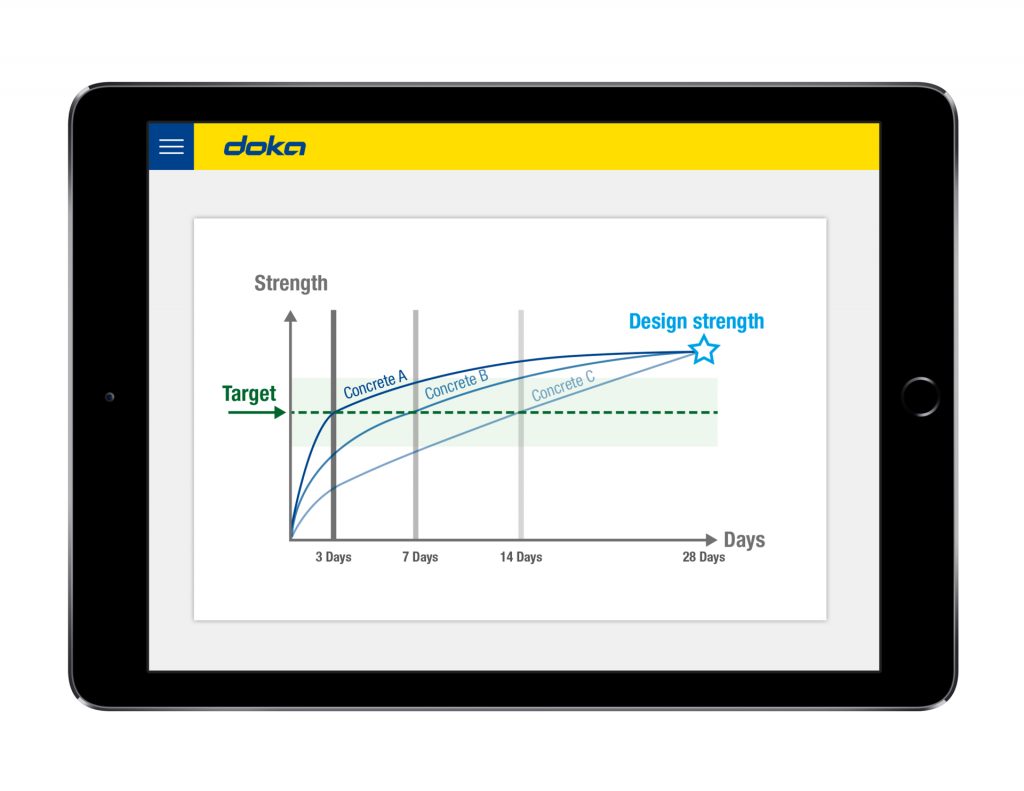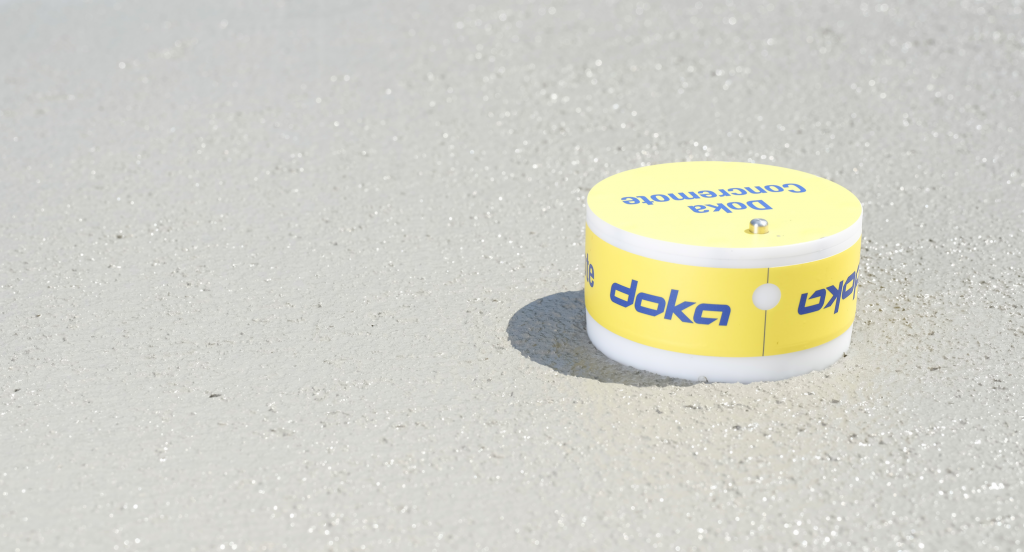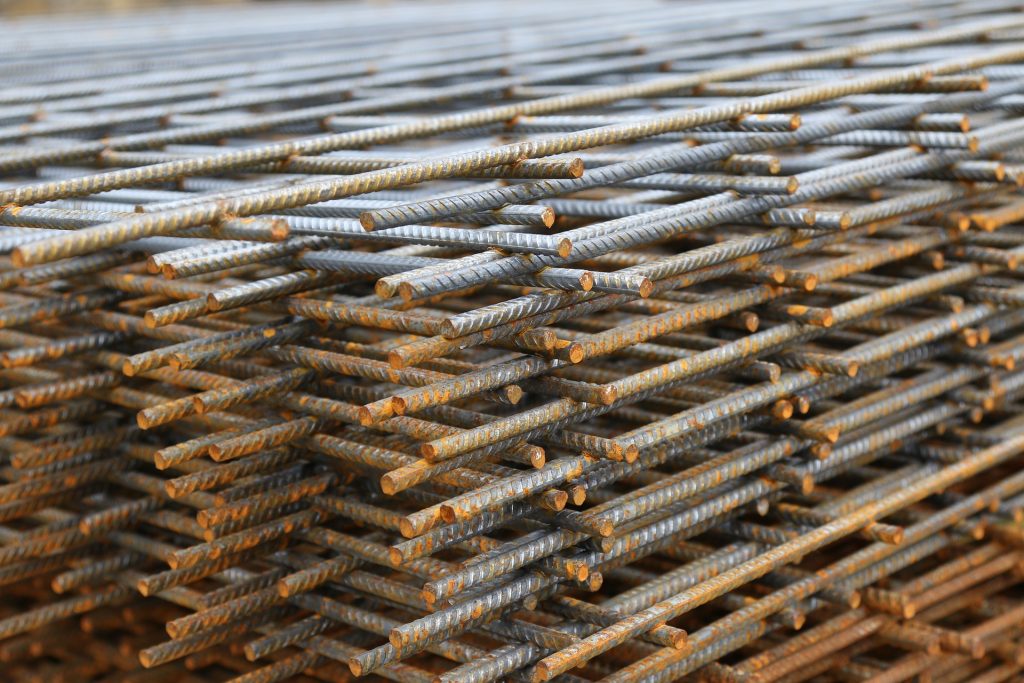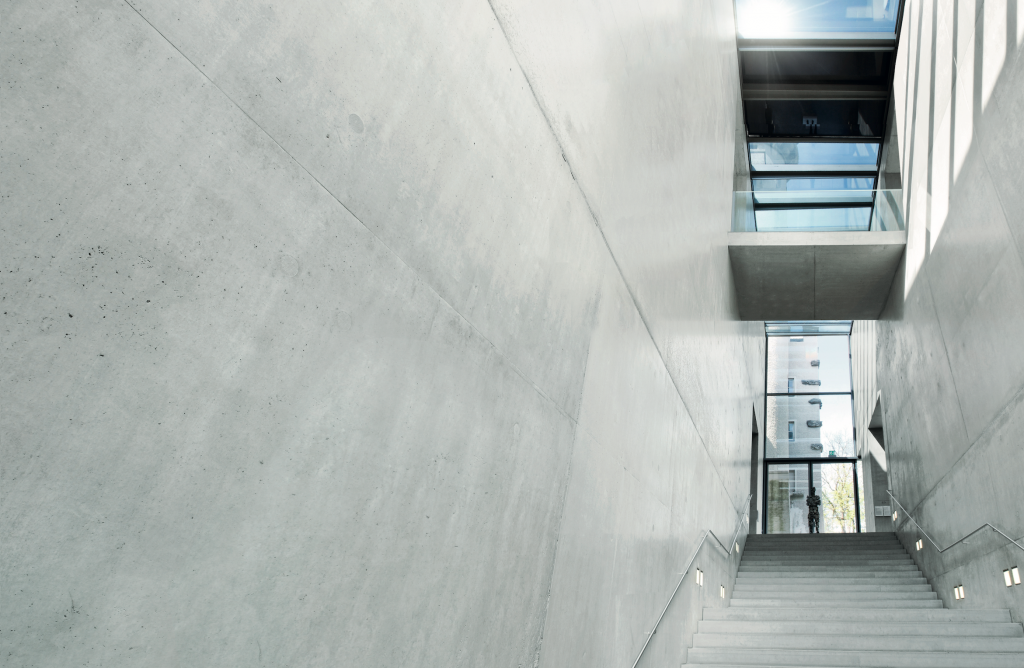Doka UK, February 3, 2020.- Concrete is durable, resilient and versatile. It is used for numerous projects ranging from commercial high-rise buildings to major infrastructure projects, such as tunnels, bridges and energy from waste facilities. It is also commonly used for smaller civils structures such as stations, culverts and retaining walls along with many other uses. Formwork and shoring systems provided by Doka require cast-in-place concrete – concrete that forms on site and is poured directly into formwork shutters. In cast-in-place concreting, selecting the right concrete mix amongst other factors are crucial in terms of construction practice and formwork engineering. In this article, we discuss further important factors and the advantages of cast-in-place concrete, with reference to a variety of sources.
What is concrete?
The Concrete Society describes concrete as “a versatile construction material that can take up any shape. It has strength and durability. Concrete is a composite material made from cement, aggregates (both coarse and fine), water, additives and invariably an admixture.”
Water and cement together form cement paste. The cement paste hardens into cement stone, bonding the aggregates together. The pores in the concrete come into being during processing and hardening. The properties of the fresh and solid concrete can be influenced by the use of the following additives:
- Chemical admixtures
- Mineral admixtures
In concrete technology, additives (such as fly ash, cinder to replace a certain amount of cement) can be added. Admixtures, for example plasticizers and retarders can also be added to change properties of fresh or hardened concrete.
There are many forms of concrete. In all cases they are produced using a varied selection of constituent materials brought together to form a semi-homogeneous solid. The name given to the many types of concrete available is either a reflection of its final application, for example pre-stressed concrete, or the properties of the concrete, for instance lightweight concrete. Just a few benefits of concrete include its versatility as it can be molded into practically any shape, low maintenance costs and exceptional strength, durability, longevity and resilience.
A number of national and European design standards and specifications (e.g. BS 5400, BD57/01, BS 8500 and BS EN 206) [3, 1, 4, 5] set out the requirements for concrete construction, identifying the required cover to reinforcement, cement content, water/cement ratio and cement type. Following these recommendations will ensure that the concrete is resistant to carbonation and chloride ingress, providing an extended working life.
The importance of concrete mix
There are many factors which must be considered when selecting the concrete mix. Concrete has a dual strength classification e.g. C28/35 to allow for both cylinder and cube compressive strengths. The second number is the cube strength more commonly required in the UK market. It is important that the full classification is to be given to avoid misunderstanding. BS 8500 covers the selection of concrete and cover to reinforcement to suit design exposure conditions. There are six exposure classes to BS EN 206-1 which is discussed in further detail in a previous blog article ‘A guide to visual and architectural concrete finishes’.
The Constructor Online states that the concrete mix design is the process of finding right proportions of cement, sand and aggregates for concrete to achieve target strength in structures and matching the desired cycle times on site at optimum costs. So, concrete mix design can be stated as Concrete Mix = Cement:Sand:Aggregates. The concrete mix design involves various steps, calculations and laboratory testing to find right mix proportions. This process is usually adopted for structures which requires higher grades of concrete such as M25 concrete grade and large construction projects where quantity of concrete consumption is large.
Selection of the correct concrete for use in any application must consider the exposure conditions, the effect of tolerances on the specified concrete cover, the intended working life, the required finish, the method of placing and the means of compacting the concrete. Specifications therefore should, where appropriate, include requirements other than strength, such as maximum water/cement ratio, cement,aggregate type and maximum grain size of aggregates.
Doka Concremote can help with the selection of the right concrete mix
Required compressive strength used to calculate the construction cycle and loading is just one factor that can affect the concrete mix design. It is one of the most important properties of concrete and influences many other describable properties of the hardened concrete. The mean compressive strength required at a specific age of 28 days, determines the nominal water-cement ratio of the mix. The other factor affecting the strength of concrete at a given age and cured at a prescribed temperature is the degree of compaction.
Doka’s digital concrete monitoring sensor, Concremote, enables contractors to make decisions on the most suitable concrete mix design. In effect, this reduces costs, including lower overhead costs related to construction time and savings by concrete mix design. Calibration of the concrete mixes enabled by the Concremote allows construction firms to assess the best mixture, and before construction work starts, they can opt for the concrete mix that will be the most cost-effective for their planned cycle time.
The Concremote system allows contractors to digitally monitor their concrete mix by providing live data on the temperature and by that, hydration and maturity of in-situ concrete. Since its launch, Doka Concremote has been used successfully on numerous major UK projects. The new version – Concremote 2.0 was launched in 2019 and provides additional features such as increased network opportunities (2G, 3G, 4G, Bluetooth), an LED signal, integrated rechargeable batteries and a smaller more robust and watertight housing unit.
The additional benefit of Doka Concremote is that it also enables contractors to plan in advance to avoid any follow-ups costs due to the digital sensors measuring the in-situ concrete maturity continuously by measuring the temperature. If temperature differences in the structure start to prove critical, contractors can react right away with the measures that will protect the quality of the concrete.


Concrete durability
Durable concrete structures must fulfil the required performance characteristics over the entirety of their projected service lives. Concrete is a chemically unstable construction material. Various influences can have a lasting effect on its resistance properties.
Important factors affecting the durability of concrete:
- Composition
- Strength grade
- Compaction
- Curing
- Temperature
Typically, concrete is used in conjunction with steel reinforcement, and this may in turn lead to other factors that affect the quality (e.g. insufficient concrete cover over the reinforcing steel).
In the course of the planning work, it is advised for a list to be drawn up of all ambient conditions – both chemical and physical – to which the concrete is exposed. The requirements regarding the composition of the concrete and the concrete cover can then be worked out from this list.
Another factor that can affect the quality of the concrete is related with the temperature of the concrete during the early age after being poured on site, especially in large concrete structures.
The exothermic cement hydration process releases heat which then heats up the core of the concrete structure more than the peripheral areas. It is worth noting that there are two dangerous effects for the quality of the concrete:
- Maximum temperature in the core
If the temperature is higher than 65-70°C, the concrete may be destroyed from the inside (Delayed Ettringite Formation). If this occurs, it is not possible to repair the destroyed areas and the concrete has to be formed from scratch.
- If the temperature varies too much between core and peripheral areas
Temperature related tensile stresses at the surface of the concrete can result in thermal cracks. If concrete becomes damaged, cracks may begin to appear which could enable oxygen and chlorides to enter which will deteriorate the concrete and reduce the service lifetime of the structure.
Concremote measurements and data are the base for the right on-time decisions on curing operations, which strongly influence concrete quality and durability.
The right formwork can help reduce stripping times
With modern high-tech concretes, it is possible to minimise the cycle even further. The chosen formwork can be a significant cost factor when it comes to cast-in-place concrete, so it becomes necessary to minimise forming times where possible. This can be achieved through cost-effective use of formwork and accompanying services, which Doka are able to advise on.
The forming time has an effect on the colour of the finished concrete surface. Keeping forming time short makes it possible to produce light-coloured surfaces (fair-faced concrete). In addition to this, forming times are also an important influencing factor in the overall construction process.
Structural planners often demand long forming times particularly for safety reasons. However, the decisions regarding forming and stripping usually rest with site management. Doka Concremote helps site management to become confident at meeting strict safety requirements whilst still achieving lowered costs which are associated with earlier stripping times. In addition to this, with the forecast element of the digital portal, it is possible to make forecasts regarding the time when the target compressive strengths are likely to be achieved given estimated weather conditions and other factors such as the concrete mix itself, this in turn enables the contractor to better plan for follow on activities and labour scheduling.
Responsibility of site management:
- To define stripping times
- To maintain compliance with the maximum permissible loads
- To check the properties of the concrete as per site delivery note
- To monitor temperatures during placement and stripping
- To cast and compact following the standards
Principles for stripping:
- Experience of site management/lead contractor
- Tables for stripping times as per construction codes

We have already referenced in a previous article ‘A guide to visual and architectural concrete finishes’ a guide to selection of the right concrete. With reference to Construct, the Concrete Structures Group and a cement and concrete industry publication ‘National Structural Concrete Specification for Building Construction’ (NSCS) published by The Concrete Centre, we take further guidance on selecting the right concrete:
Selection of the correct concrete for use in any application must consider the following:
- Exposure conditions
- The effect of tolerances on the specified concrete cover
- The intented working life
- The required finish (refer to previous blog article)
- The method of placing
- The means of compacting the concrete
Specifications therefore should, where appropriate, include requirements other than strength, such as maximum water/cement ratio, cement and aggregate type.
Types of in-situ concrete
There are a multitude of different blends of concrete available for all types of uses. We discuss some of the most common types below:
Reinforced concrete:
Doka partner with many reinforced concrete frame contractors in the UK and around the world. Reinforced concrete is a common type of concrete used with formwork systems and provides excellent structural integrity over a long period with relatively little maintenance. The combination of concrete and steel permits low cost and high speeds of construction making it an attractive material for owners, architect and engineers.
Reinforced concrete can be formed in an array of designs, finishes, patterns, and colours making it an ideal choice for many structures. Reinforced concrete also has a high compressive strength compared to other building materials.

Applications:
- Buildings
- Water Tanks
- Road and Rail Bridges
- Tunnels
- Retaining Walls
- Bunkers and Silos
Fair-faced concrete:
Fair-faced concrete is a formed concrete whose surfaces have to fulfil stringent specifications.
These requirements can relate to:
- Evenness
- Porosity
- Surface structure
- Uniform colouration
It is particularly important to ensure that the solids sizing in the mix is very uniform. Additionally, cement content should be at least 300 kg/m3.
The quality of the fair-faced concrete also depends on the following factors:
- Type of formwork
- Release agent
- Temperatures
- Maturity of concrete
- Ambient temperature, including the temperature of the fresh concrete
- Humidity
With watertight formwork, water bubbles or air bubbles can form more easily at the surface than is the case with absorbent formwork. Unevenly applied release agent leads to clouding on the fair-faced concrete surface.
In fair-faced concrete projects, architects and project owners usually require an equal or a similar grey colour tone between neighbouring casting steps.
Concrete maturity is one of the most important parameters that influence the colour of fair-faced concrete, therefore stripping the formwork at equal concrete maturity levels will increase the probability to end with a more similar colour tone between the casting steps.
The real-time maturity data provided by Concremote sensors enables the jobsites to take decisions in fair faced concrete projects.
Pre-stressed concrete:
Pre-stressed concrete is a type of reinforced concrete with an additional longitudinal axial force.
A distinction is made between 2 types:
- Bonded pre-stressing (pre-tensioning): The tensioning cables (tendons) are frictionally bonded with the concrete. After the concrete has been poured and allowed to set, the tensioning force is transferred from the bonded tendons to the building element.
- Unbonded pre-stressing (post-tensioning): The tensioning cables are able to move, relative to the concrete, between the anchor-points. Inside tensioning cables retain their freedom of movement by being coated with a layer of grease. Outside tensioning cables are also possible, except where they are anchored to the building element.
Applications:
- Bridge-building, tank construction
- Prefabricated members (trusses, hollow-core slabs, flat-slab floors)
Shotcrete:
The Concrete Society defines shotcrete – also known as sprayed concrete (SpC) as a process by which concrete or mortar is conveyed through a hose and projected pneumatically at high velocity from a nozzle into its final location. This particular approach is used for both new construction, for example, this is commonly used as in-situ linings for tunnels and is also frequently used for repairs. No other compaction is required but the surface may be finished by hand if required.
Applications:
- Stabilising exposed areas of rock or unconsolidated material in tunnel-building.
- Rehabilitating and strengthening concrete and reinforced concrete constructions.
Self-compacting concrete:
Self-compacting concrete de-aerates itself, and flows until it finds its own level, under the influence of gravity alone. No compaction (by external vibrators) is needed. Despite its high flowability, no settling-out of the aggregates takes place (i.e. the concrete shows no signs of de-mixing).
Concrete composition:
- High proportion of meal (fine grains)
- High plasticiser content
- Regular cement content
- Regular w/b ratio
Typical uses:
- Complicated formwork shapes
- Slender, filigree structures
- Structured fair-faced concrete surfaces
- Structural elements with high proportion of reinforcement
- Structural elements with closely spaced reinforcement
Advantages:
- Does away with compaction work
- Consistent concrete quality through the entire cross-section of the structure member.
- No noise nuisance from compaction operations
- Cross-sectional dimensioning depends on structural- design requirements only
Disclaimer: Information contained within this article is for information only, for specific project planning, you should always consult your planning and consulting specialist.
Sources:
- The Constructor Online
- Concrete Framed Buildings – The Concrete Centre







